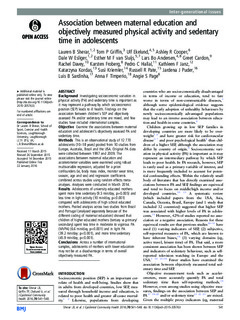| dc.description.abstract | Background: Investigating socioeconomic variation in physical activity (PA) and sedentary time is important as it may represent a pathway by which socioeconomic position (SEP) leads to ill health. Findings on the association between children's SEP and objectively assessed PA and/or sedentary time are mixed, and few studies have included international samples. Objective: Examine the associations between maternal education and adolescent's objectively assessed PA and sedentary time. Methods: This is an observational study of 12 770 adolescents (10–18 years) pooled from 10 studies from Europe, Australia, Brazil and the USA. Original PA data were collected between 1997 and 2009. The associations between maternal education and accelerometer variables were examined using robust multivariable regression, adjusted for a priori confounders (ie, body mass index, monitor wear time, season, age and sex) and regression coefficients combined across studies using random effects meta-analyses. Analyses were conducted in March 2014. Results: Adolescents of university educated mothers spent more time sedentary (9.5 min/day, p=0.005) and less time in light activity (10 min/day, p<0.001) compared with adolescents of high school educated mothers. Pooled analysis across two studies from Brazil and Portugal (analysed separately because of the different coding of maternal education) showed that children of higher educated mothers (tertiary vs primary/secondary) spent less time in moderate to vigorous PA (MVPA) (6.6 min/day, p=0.001) and in light PA (39.2 min/day: p<0.001), and more time sedentary (45.9 min/day, p<0.001). Conclusions: Across a number of international samples, adolescents of mothers with lower education may not be at a disadvantage in terms of overall objectively measured PA | nb_NO |
